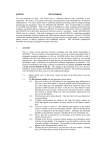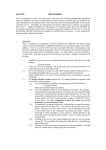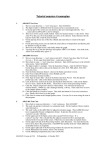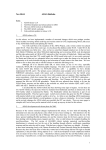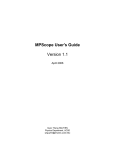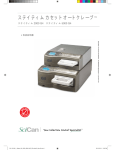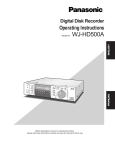Download Bulletin for ADAS v1.4
Transcript
nov18-95 ADAS Bulletin Two new programs are ready. They are the first of the ADAS series 4 ionisation and recombination processing codes. ADAS401, allows interrogation of condensed master files (adf10). These are datasets of recombination coefficients, ionisation coefficients, power coefficients etc. stored in isoelectronic sequence groups. ADAS405 is an equilibrium ionisation balance code capable of working with either unresolved (stage to stage) or resolved (metastables distinguished) iso-nuclear master file datasets (adf11). It is quite sophisticated allowing production and display of generalised contribution functions as well as the more usual fractional abundances and power functions. I hope its capabilities will prove helpful. These programs are the first of their type and have proved quite time consuming for Tim to convert. Meanwhile Alessandro has being working hard on a differential emission measure analysis code and environment - it has been set up also to become an ADAS utility. The code is quite complex and uses the integral inversion core by Alan Thomson. This code is presently under test at Strathclyde University and at Rutherford-Appleton Laboratory but without its final ADAS title and menu position decided. We can make arrangements for consortium members with special interest in this code to have preliminary access to it. It will probably be issued in ADAS release 1.5. A number of errors have been corrected and adjustments made in this release (1.4) including some in ADAS101, ADAS209 and ADAS506. Remember that it is safest to remove your defaults directory member for a corrected program and allow ADAS to recreate it. Admittedly, I usually forget and only realise I have not done so when a program unexpectedly jumps me back to the main menus. 1. ADAS401 The program interrogates condensed iso-electronic master files of ADAS data format adf10. They fall into two types, standard and partial, depending whether metastable states are distinquished and treated along with ground states or if only ground states themselves are addressed. We call the two cases also the metastable resolved and metastable unresolved pictures. Data classes include free electron recombination coefficients (ACD), electron impact ionisation coefiicients (SCD), charge exchange recombination coefficients (CCD), recombination-bremsstrahlung power coefficients (PRB), charge exchange power coefficients (PRC), low level excitation line power coefficients (PLT), metatsable cross-coupling coefficients (XCD) and parent metastable cross-coupling coefficients (QCD). All these coefficients are effective coefficients in the (generalised) collisional-radiative sense. Note that adf10 files are stored by iso-electronic sequence and so a particular file may have data for several members of an iso-electronic sequence. They are designed to allow interpolation in ion charge along an iso-electronic sequence as common z-scaled temperatures and densities are used for series members present. More details are given in the ADAS User Manual ,chap5-01. 1.1. Move to the directory in which you wish any ADAS created files to appear. These include the output text file produced after executing any ADAS program (paper.txt is the default) and the graphic file if saved (e.g. graph.ps if a postscript file). Inititate ADAS and move to the series 4 menu. Select ADAS401. 1.2. The file selection window appears first and is illustrated below. Its operation is somewhat more elaborate than the standard one (cf. bulletin jan18-95). 1.2.1. adf10 is the appropriate format for use by the program ADAS401 (ADAS User Manual, appxb-10). Your personal data of this type should be held in a similar file structure to central ADAS, but with your identifier replacing the first adas. 1.2.2. Available sub-directories and data files are shown in the file display window (a). Selection is made by clicking on the appropriate name whereupon it appears in the selection window above. Buttons are present to set the data root to that of the Central data or to your personal User data (provided it is in ADAS organisation. Alternatively the ‘data root’ may be edit explicitly. 1.2.3. ADAS401 relies on the structure of the file name file to identify the organisation of the data within it. The key fields lie between the underscore, ‘_’ and ‘.dat’ parts of the file name (a). The characters (eg. be or b) specify the isoelectronic sequence, that is the (lower case) chemical symbol of the first member of the sequence. If no digits follow the chemical symbol, the file is of standard type. Otherwise the data set is of partial type and there are two digits indexing initial and final metastable states. The exact definitions are given in the User Manual. There is a known error. Data of type PLT in the partial case has the digits replaced by ‘##’. Such data cannot be interrogated at this time by ADAS401. ADAS401 INPUT Input Iso-electronic Master File Data root /disk2/adas/adas/adf10/ Central data User data Edit Path Name acd93/acd93_be12.dat .. acd93_b11.dat Data File acd93_b12.dat acd93_b21.dat acd93_b22.dat a) Search for input file from details :- Iso-electronic master collisional-dielectronic class : ACD - Recombination coefficients Year of data : 93 Iso-electronic sequence symbol : be Type of file : Partial First index : b) Second index Any : c) Any Member prefix : Browse Comments Search Cancel Done d) 1.2.4. 1.2.5. To ease file selection, an alternative strategy is available. Central ADAS data makes use of the data class in lower case (eg. ‘acd’) and a two digit year number (eg. ‘93’) to assemble a standardised file name such as shown at (a). Files can be located by specifying these name parts in the ‘Search for input file details’ window. Click on the appropriate boxes to present either a drop down choice or to make the window editable (cf. (b) and (c)). Click the Search button to present a list of files satisfying the entered fields in the Data File window at (a). Thus ‘Any’ may be entered for the First index or Second index to show all partial files for the selected sequence and year. Clicking on the Browse Comments button displays any information stored with the selected datafile. It is important to use this facility to find out what has gone into the dataset and the attribution of the dataset. The possibility of browsing the comments appears in the subsequent main window also. 1.2.6. Clicking the Done button moves you forward to the next window. Clicking the Cancel button takes you back to the previous window. The processing options window has the appearance shown below 1.3.1. Data file information is given at (a) and iso-electronic sequence information at (b). 1.3.2. A particular member of the iso-electronic sequence is selected at (c). This is by entering any one of the three fields, namely, element nuclear charge (nuclear charge number or symbol), recombined ion charge or recombining ion charge. Remember to press Return after entering a value in an editable window. 1.3.3. The extracted data is interpolated by a cubic spline to the selected ion and user temperature/density pairs for graphical display and tabular output. Additionally a polynomial approximation may obtained by making the appropriate selections at (d). 1.3. ADAS401 PROCESSING OPTIONS b) a) Title for run : Data File Name : /disk2/adas/adas/adf10/acd93/acd93_be12.dat Browse Comments Data file information :- Iso-electronic sequence info :- Class : ACD - Recombination coefficients Year : 93 File type : Partial Symbol Number of electrons 1st (upper) index 2nd (lower) index Enter one of the following ion selection parameters :- : Be :4 :1 :2 Polynomial Fitting Element nuclear charge/symbol z0 : 35 (4 - 50 / Be - Sn ) Recombined ion charge z : 31 (0 - 46 ) Recombining ion charge z1 : 32 (1 - 47 ) Fit Polynomial value % : 10 Select Output Temperature / Density pairs Temperature & Density Values Temperature Density Index Output Input Output Input 1 2 3 4 1.000E+00 2.000E+00 5.000E+00 1.000E+00 1.000E+00 2.000E+00 5.000E+00 1.000E+01 1.000E+12 1.000E+12 1.000E+12 1.000E+12 1.000E+11 2.000E+11 5.000E+11 1.000E+12 Temperature Units : eV c) d) Density Units : cm-3 Edit Table Default Temperature / Density Values e) Edit the processing options data and press Done to proceed Cancel Done 1.3.4. The selection of temperature and density pairs for data output are made at (e). The source data is held in two-dimensional arrays, that is as a function of z-scaled electron temperature and z-scaled electron density. The source values are also shown at (e). The table may be edited by clicking on the Edit Table button.. The ADAS Table Editor window is then presented with the 1.4. same set of editing operations available as are described in bulletin nov1894. 1.3.5. Clicking the Done button causes the output options window to be displayed. Remember that Cancel takes you back to the previous window. The Output options window is shown below. Broadly it follows the pattern of other ADAS interrogation codes. 1.4.1. Graphical output is enabled by clicking on the button at (a). Default scaling of graphs may be over-ridden by appropriate selections at (b). Hard copy may be enabled at (c) with the type of output device selected at (d). 1.4.2. In addition to the plot of data according to the user values of ion, temperature, density etc. entered on the Processing Option window, additional plots of adjacent data may be made on the same graph. This is to give some guidance on the accuracy of interpolations and whether the adf10 grids are sufficient dense for particular user tasks. Adjacent members of the iso-electronic sequence to the ion sought by the user, present in the source data set, may be shown. Click at (e) to drop down a selection list of available ions. The supplementary plots can only be provided at an electron density for which data are present in the source file. Select this density in the window above (e). ADAS401 OUTPUT OPTIONS Data file name : /disk2/adas/adas/adf10/acd93/acd93_be12.dat Browse comments Graphical Output Graph Title Default Device Post-script Figure 1 a) Post-script HP-PCL HP-GL Explicit Scaling X-min : X-max : Y-min : Y-max : d) b) Enable Hard Copy File name : Replace graph.ps c) Select electron density for plot (units : reduced ) : 1.000E+06 Choose input z1 values for plot (default : all ) Click to choose Text Output File name : Cancel 1.4.3. Replace : Default file name paper.txt Done As usual a line printer text output file summarising the interrogation may be produced. e) 2. ADAS405 The program computes an equilibrium ionisation balance for an element or a range of ions of an element by drawing on relevant iso-nuclear master file data (format adf11). These data consist of (generalised) collisional-radiative coefficients for the ions of the element and may be of the stage-to-stage (standard) form or of the metastable distinguishing form (partial). The program calculates also the equilibrium radiated power by the element. A main objective of the code is to generate ionisation equilibrium emissivity functions for specific spectrum lines. These quantities, also known as (generalised) contribution functions, combine emissivity coefficient data with ionisation balance fractional abundances. They are the most relevant quantities for analysis of spectral observations of ionisation equilibrium plasmas (cf. differential emission measure analysis). ADAS405 achieves this by drawing on photon emissivity coefficient data collections in the ADAS database (‘pec’ files of format adf15). The capability for interrogating and accessing these data collections have already been provided in the IDL-ADAS conversion (see ADAS503 and bulletin nov18-94). ADAS405 makes use of a script, prepared by the user, to specify the pec data required from the ADAS database. The usual practice is that separate scripts are prepared for each particular application. Line ratios may also be specified in the script. Full details are given in the ADAS User Manual (chap505). ADAS405 INPUT Enter details of the iso-nuclear master files to be analysed :Select iso-nuclear master collisional-dielectronic classes Radiated power filter (blank for none) : Select : a) Member prefix (blank for none) : Year of data Type of master files : 93 Partial : b) Select directory branch : User Default year (if required) : 93 Iso-electronic sequence symbol : c Specify partial type code : c) Resolved Display data set availability d) Input Line and Analysis Selection File :Data root /disk2/adas/adas/scripts405/ Central data User data Edit Path Name test_c .. NULL Data File test_c e) Browse Selection FileComments Cancel Done f) 2.1. Move to the directory in which you wish any ADAS created files to appear. These include the output text file produced after executing any ADAS program (paper.txt is the default), the graphical output file and the generalised contribution function file 2.2. formatted to adf16 specification. Initiate ADAS405 from the program selection menus in the usual manner. The file selection window appears first as illustrated below. Its operation is somewhat similar to that of ADAS401 above. 2.2.1. Two types of data file are identified in the file selection, namely, the isonuclear master files required for the ionisation balance and power calculations and the script file. The top part of the file selection window is concerned with identifying the master file data required and the lower part with identifying the script file. 2.2.2. adf11 is the appropriate data format for use by the program ADAS405. Your personal data of this type should be held in a similar file structure to central ADAS, but with your identifier replacing the first adas. The central ADAS database has extensive data of this form and the collection is steadily being extended. It is also subject to periodic revision as the influences of improved fundamental data are computed. 2.2.3. Click on the Select button at (a) to drop down a selection list of master file data classes. Activate the buttons at the data classes required for your analysis. It is obligatory to select the ‘acd’ and ‘scd’ electron impact effective recombination and ionisation data classes since otherwise an ionisation balance cannot proceed. However the other data classes selected are at the user’s choice. This enables investigative studies of the importance of different contributions for example to radiated power. 2.2.4. At JET Joint Undertaking, effective radiated power coefficients (‘prb’, ‘plt’ and ‘prc’) are often made available both as the whole emitted power and as the power which would pass through certain filters (such as Be/Si windows). The filter is specified either simply as an energy cut-off (eg. ev2000) or as filter specification (eg. ft1235). These codes appear as an extension in the relevant master file names. Specify the filter choice at (b). Note the present IDL-ADAS database contains very little filtered power data but it can be added if there is an interest amongst users. 2.2.5. The remainder of the file identification (c) follows the general pattern described for ADAS401 above. Note that a default year must be specified. Often the complete set of data classes for a particular year and type are not available and the capability of filling in from a default (perhaps less accurate but more complete) year is allowed. 2.2.6. In general the two digit year number is used to provide the main groupings of data. Thus ‘89’ is the standard, unresolved, JET base line data of low precision but fairly complete. ‘93’ is metastable resolved data, but available only for light elements of primary importance to fusion. Some flexibility for subdivision within a year is provided by allowing a two character ‘member prefix’ (eg. ‘pj’) which may be present in the final part of a file name (eg. ‘/.../acd93r/acd93r_pj#c.dat’). 2.2.7. The distinctions between standard and partial master file types and resolved and unresolved types must be clarified. Standard data is stage -to stage and has a specific layout. Partial data distiguishes metastables and has a different layout. Within the partial data layout it is possible simply to have each stage represented only by its ground state and therefore to be similar to standard data However the layout is the partial one. We call such data partial but unresolved. The usual partial data with metastables present is called resolved. This distinction and added flexibility are helpful in isonuclear master file preparation and archiving. 2.2.8. Clicking the Display data set availability button at (d) causes display of a file availability summary window as illustrated below. It is important to use this facility since it shows which master files classes sought by the user were not available, where default data files were substituted etc. 2.2.9. Script file selection is made in the conventional manner at (e). We have found it convenient to group script files in a personal ADAS database under a subdirectory classification /scripts405/. Also, it is possible to bypass contribution function calculation and display by selecting the ‘NULL’ script. You may find it helpful to copy the ‘NULL’ script from the central ADAS database to your own space. Note that scripts apply to particular cases. Thus the references to emissivity coefficient data in a script applying to metastable resolved will not in general work for unresolved data, indeed will probably crash. We have not built much protection against faulty references into script files at the moment. More protection may be added if this proves a stumbling point for users. You may find it helpful to fetch the test_c script from central ADAS for first trials. Class selection and file availability :Class Year Element -------- ------ ----------acd scd ccd prb prc qcd xcd plt 93 93 93 93 93 93 93 93 c c c c c c c c Member Power Prefix Filter -------- ------- Type -----Rpartial Rpartial Rpartial Rpartial Rpartial Rpartial Rpartial Rpartial USER DATA DEFAULT DATA (93) Selected Availability Used Available ------------ ---------------------- ------------YES YES no YES no YES YES YES YES YES no YES no YES YES YES no no no no no no no no YES YES no YES no YES YES YES All requested files available from user data sets. OK 2.3. 2.4. The processing options window has the appearance shown below 2.3.1. The script file selected by the user is identified at (a). The Browse Comments button displays the comments field at the foot of the script file. 2.3.2. Information is presented at (b) of the element and master files classes selected in the previous file selection option step. 2.3.3. Enter isotope mass numbers for the selected element and background neutral hydrogen in the plasma at (c). This information is only used if charge exchange recombination master file data has been selected. 2.3.4. The spectrum lines set up in the script file are shown in the display window at (d). This operates in the same manner as line display and selection windows in interrogation codes such as ADAS503 (see bulletin nov19-94). Click on a line to select it. The selected line is shown in the selection window above the display window. Only one line is treated at a time for graphical display. However all lines and line ratios in the script file are computed and tabulated in the output text file. 2.3.5. The selection of temperature and density pairs for data output are made at (e). The table may be edited by clicking on the Edit Table button.. The ADAS Table Editor window is then presented with the same set of editing operations available as are described in bulletin nov18-94. Electron temperatures should be monotonic increasing. It has proved helpful to add a Clear Table button (f) to remove all entries in the temperature and density output fields. 2.3.6. Clicking the Done button causes the output options window to be displayed. Remember that Cancel takes you back to the previous window. The output options window is shown below. 2.4.1. It follows the usual pattern except that there is a choice of graphs to display. Thus the fractional abundances, power functions and contribution functions are all of potential interest. Click on the appropriate button at (a). Generally, we find that on the first one or two occasions we wish to see the fractional abundances and powers but then have a more sustained interested in the contribution function shapes and their location in temperature. All the graphs are provided as a function of electron temperature. The window presented at (b) depends on the graph choice above. The default scaling may be over-ridden and explicit values for the graph limits entered. 2.4.2. ADAS405 PROCESSING OPTIONS Title for Run Script file : /disk2/adas/adas/scripts405/test_c Browse Comments Data file information :- Enter isotope information :- a) Selected master file element : C (amu) : 12.0 Enter hydrogen isotope mass number (amu) : 1.0 Enter element isotope mass number Selected master classes : ACD, SCD, PRB, QCD, XCD, PLT Select spectral line for analysis :- b) c) Number of listed lines in script file : 2 /,1( ,1'(; 5$',$7,1* ,21 &+$5*( 180%(5 2) &20321(176 7,7/( $1' :$9(/(1*7+ 1 0 4 CI 1561 1 0 4 CI 1561 2 1 2 CII 904 d) Enter Output Temperature/ Density data Temperatures Index 1 2 3 4 Electron Output values 1.000E+00 2.000E+00 5.000E+00 1.000E+01 Densities Hydrogen Output values 1.000E+00 2.000E+00 5.000E+00 1.000E+01 Electron Output values 1.000E+12 1.000E+12 1.000E+12 1.000E+12 Hydrogen Output values 1.000E+11 2.000E+11 5.000E+11 1.000E+12 e) Temperature Units : eV Density Units : cm-3 Edit Table Default Temperature/Density values Clear Table Edit the processing options data and press Done to proceed Cancel f) Done 2.4.3. 2.4.4. Graphical output is enabled in the window at (c) together with hard copy device and output file name. This follows the pattern of other ADAS programs. Likewise text output selection at (d) is standard. The ‘Goft Passing File’ is the name used for the output data of calculated contribution functions. It is organised according to an ADAS data format adf16. The output file name is specified at (e). The expected practice is that ADAS405 will be used either recursively or in distinct runs to examine contribution functions and then decide which to put into the Goft file. Thus an Append button has been provided to allow an existing output Goft file to be extended. The Replace and Default file name buttons have their usual meanings. ADAS405 OUTPUT OPTIONS Script file : /disk2/adas/adas/scripts405/test_c Browse Comments Graphical Output Graph Title Figure 1 )UDFWLRQDO DEXQGDQFH SORW 3RZHU IXQFWLRQ SORW a) &RQWULEXWLRQ IXQFWLRQ SORW )UDFWLRQDO DEXQGDQFH SORW Explicit Scaling X-min : X-max : Y-min : Y-max : b) Enable Hard Copy File name : Select Device Post-script Replace graph.ps Post-script HP-PCL HP-GL c) Text Output File name : Replace Default file name paper.txt d) Goft Passing File File name : Cancel Append Replace Default file name goft.pass Done e) For the next release, Tim is turning to ADAS series 3 programs associated with beam stopping. We shall begin as usual with the interrogative program on the database and then move on to the processing program. Also we are bringing up some series 5 interrogative programs ahead of schedule. David is also nearing completion on the ‘unbundling’ program (ADAS210) to match the ‘bundling’ program (ADAS 209) released earlier. I think these two programs will make it easier to cross-link between the typical astrophysical and fusion applications. More data has been added to the central ADAS database. In particular Alessandro has generated substantial additional collections of G(Te) functions of type adf20 needed for the SOHO satellite data analysis. These are located as: /.../adas/adas/adf20/* Also the adf04 collections have been extended, including the following: /.../adas/adas/adf04/copmm#li/* Peter McWhirter’s assessment for lithium-like ions from the SOHO-CDS data review /.../adas/adas/adf04/clike/* Brunella Monsignori-Fossi’s assessment for the carbon-like sequence. and data for some ions of iron assessed by Helen Mason /.../adas/adas/adf04/allike/allike_hm#fe13.dat /.../adas/adas/adf04/arlike/arlike_hm#fe8.dat /.../adas/adas/adf04/plike/plike_hm#fe11.dat /.../adas/adas/adf04/silike/silike_hm#fe12.dat. Lorne Horton and I have put up the old Sampson et al. data for the hydrogen-like sequence as /.../adas/adas/adf04/copsm#h/* but we hope to have their modification due to Callaway’s review in place shortly. The next data release including the above will put in position on all sites at the end of this week. H. P. Summers 5 Dec. 1995










